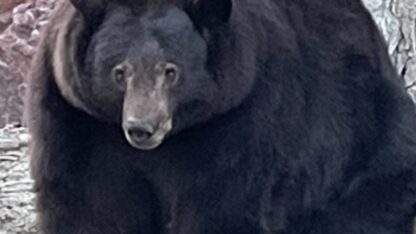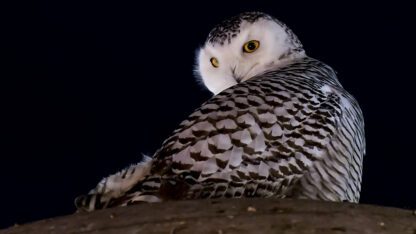On the verge of a happy ending, concerns raised about future of rare southern bird
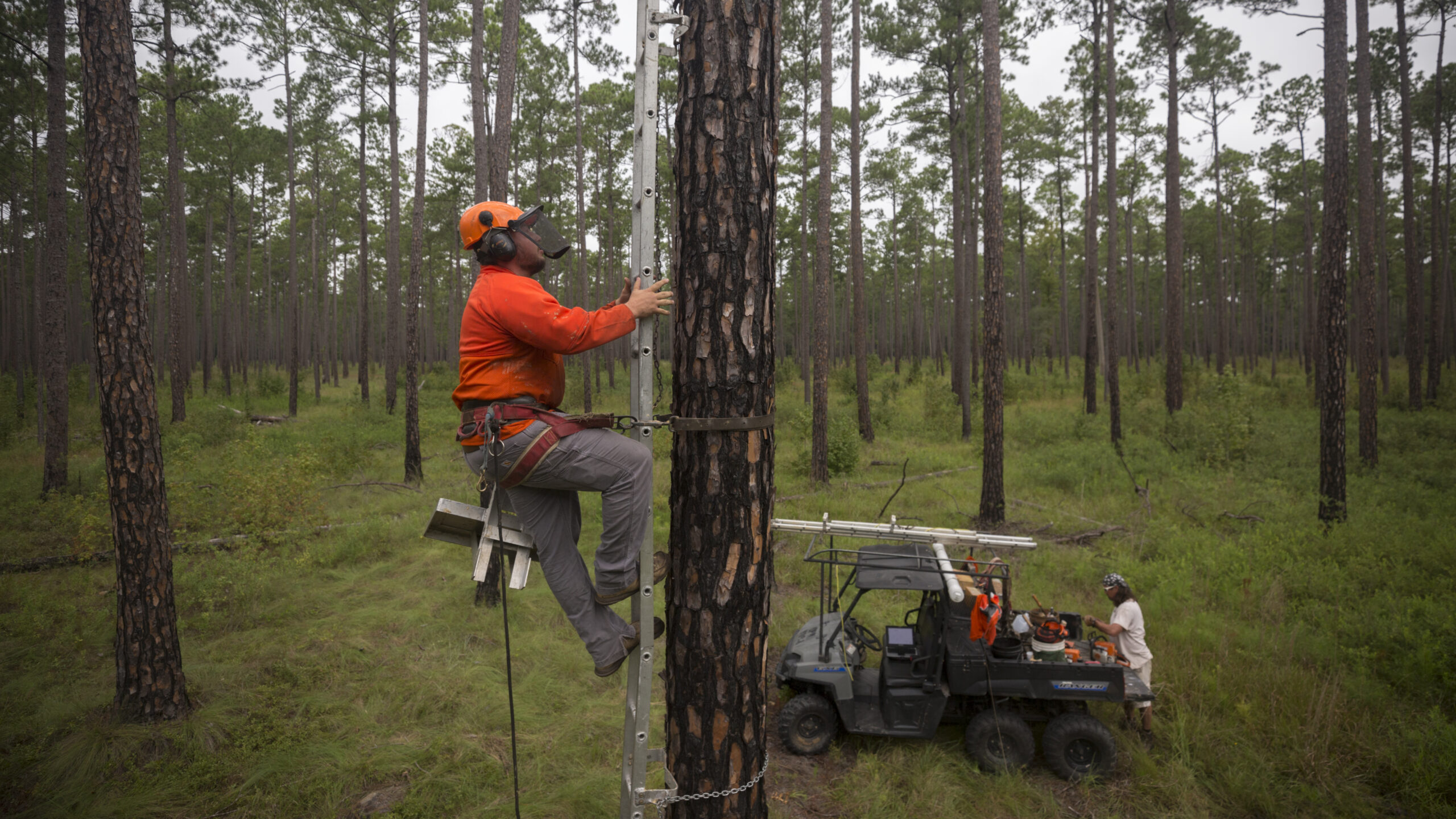
Senior Wildlife Technician Ryan Adamson climbs a pine tree at Fort Stewart before he uses a chainsaw to cut an artificial roosting cavity in the tree. It’s all part of an effort to help the endangered red-cockaded woodpeckers that live here. (Stephen B. Morton for WABE)
It’s still dark out when wildlife researchers at Fort Stewart start their day. Crickets and frogs chirp in the muggy early morning; the mosquitoes are terrible. Stepping out of their pickup parked on a dirt road, the researchers – one in a Georgia baseball hat, the other in a camo Alabama cap — close their doors gently, to keep quiet
Before dawn, deep in the woods, it’s the kind of time one might feel like whispering anyway, but they whisper so as not to wake the woodpeckers sleeping nearby.
“As you start approaching the tree, you try to be as quiet as you can,” says Georgia fan Tommy Holland, a wildlife biologist at Fort Stewart.
Holland and Josh Wimberly, a wildlife technician, are here in the longleaf pine forest to catch a family of red-cockaded woodpeckers so they can tag them. In the late summer, they’re out just about every morning doing this work. It’s easiest to creep up to the trees around dawn, to net the woodpeckers as they wake up.
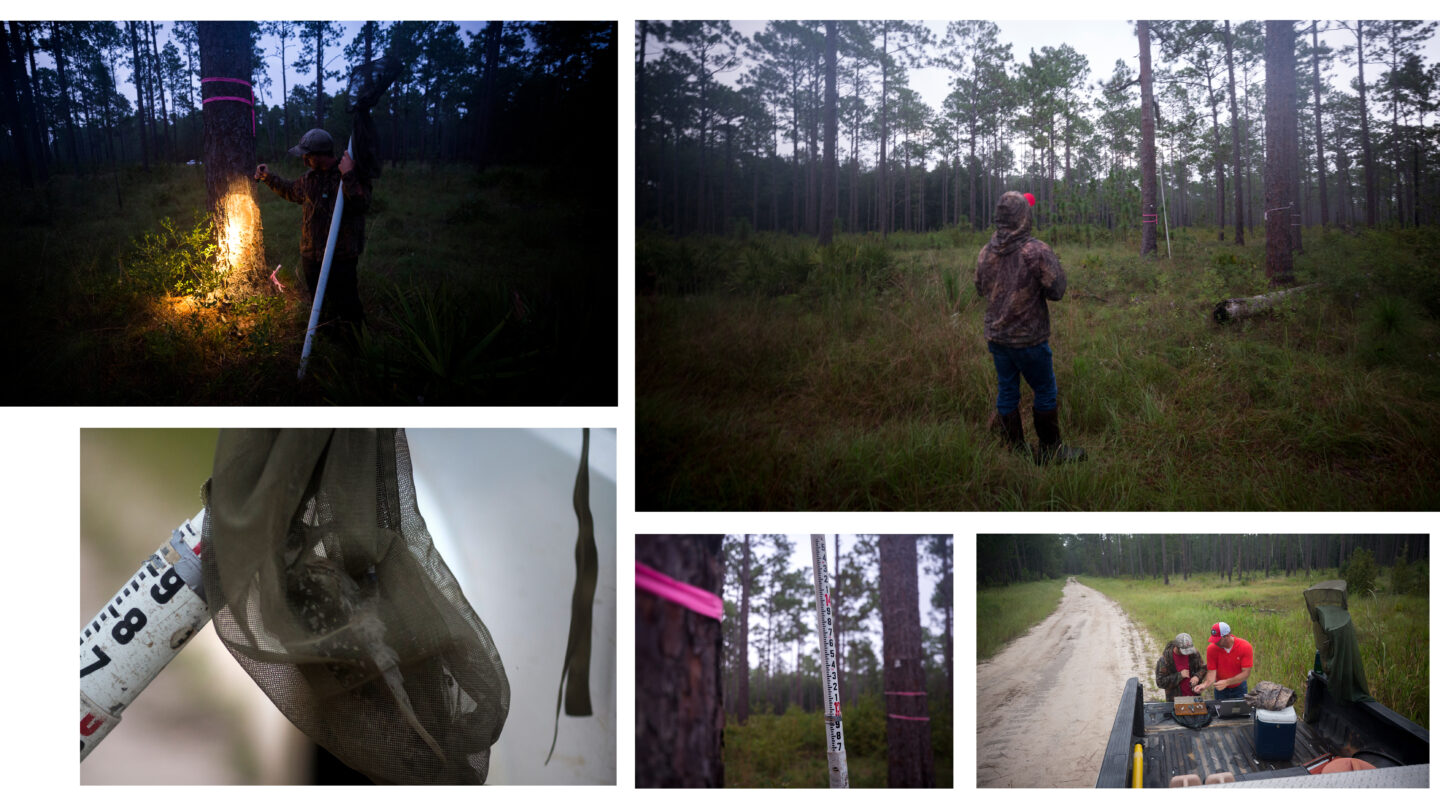
“You find they’re like people,” Wimberly says. “Some of them sleep hard, some of them are very light.”
Fort Stewart, near Savannah, is the largest Army installation east of the Mississippi River, a place where thousands of troops live and train. It’s also home to a large population of red-cockaded woodpeckers, a bird that was likely once common, but has been considered endangered for decades.
Now, the little black and white woodpecker is on the cusp of being an environmental success story in Georgia and across the Southeast. It’s doing well enough that there’s been talk of downgrading its protections.
But some are concerned that the little bird isn’t ready for that.
A Changing Landscape
Red-cockaded woodpeckers have been considered endangered by the U.S. Fish and Wildlife Service since 1970, three years before the Endangered Species Act was even passed. The problem for the woodpeckers, as it is for so many species, was habitat loss. The longleaf pine forests of the Southeast where the red-cockaded woodpeckers live were rapidly disappearing.
“People recognized that if we lost all of our mature longleaf forests, then we’d lose the red-cockaded woodpecker along with it,” says Larry Carlile, acting chief of the Fort Stewart/Hunter Army Airfield fish and wildlife branch.
Carlile has worked on woodpeckers at Fort Stewart for 25 years, and though he’s mostly tied to a desk these days, he’s showing me around on this buggy early morning.
As the sun starts to come up – and the mosquitoes are somehow, impossibly, even worse – Carlile points through the trees to where Wimberly has set up to catch a bird. Wimberly raises a net up on a telescoping pole to block a hole about 20 feet up a tree.
Red-cockaded woodpeckers live in family groups, but each has its own cavity in its own tree. Offspring often stay – sometimes for years – with their parents to help raise their younger siblings. Adult males have red feathers on the sides of their heads, hence the “red cockade” in their name.
Almost as fast as I can find Wimberly in the gray early morning, Carlile says Wimberly’s caught the bird – he can hear it fluttering in the net.
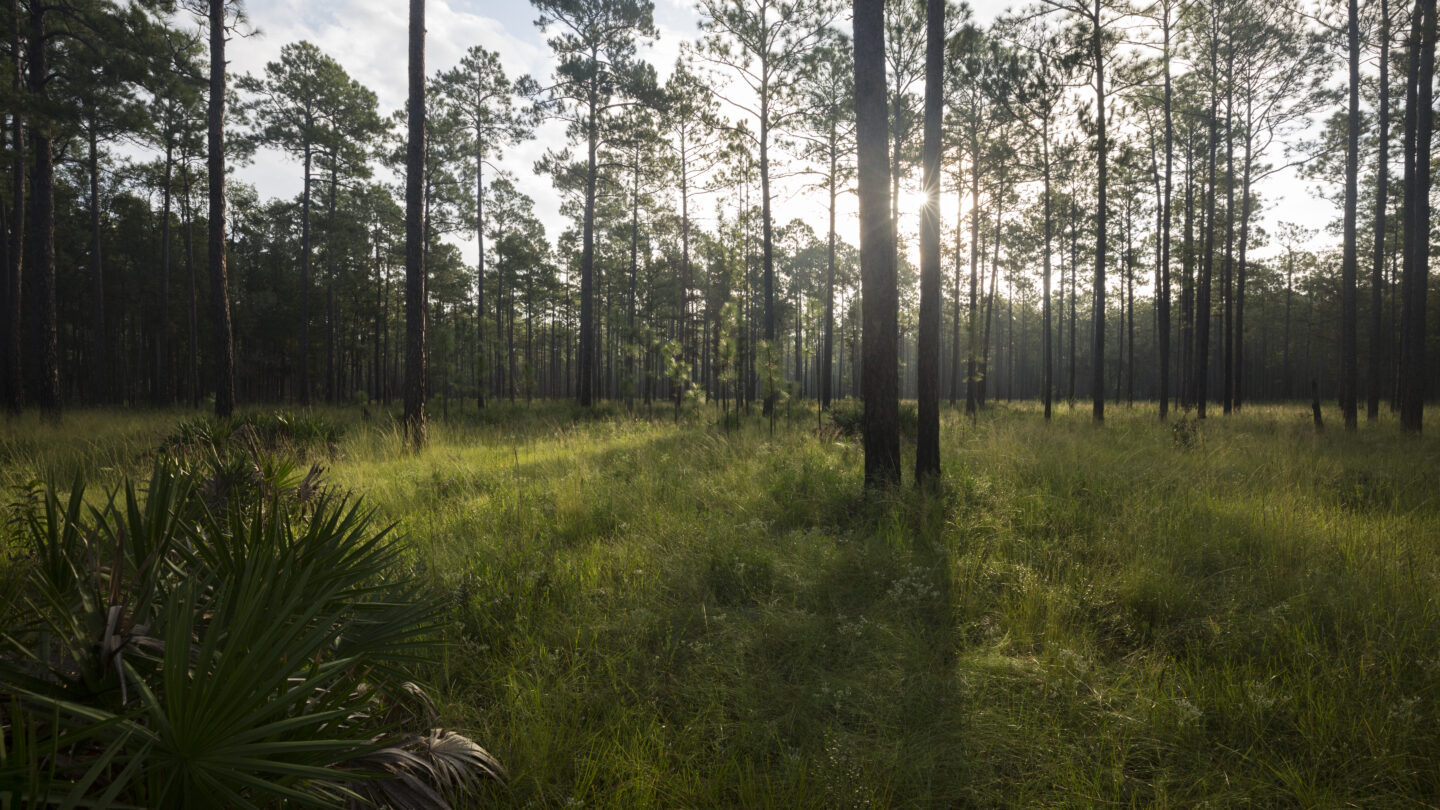
Longleaf pine used to be the dominant tree across millions and millions of acres of woods in the South.
It’s a long-lived pine tree, slow growing and straight, with puff balls of long needles. And it’s adapted to fire, which clears out competition and underbrush; healthy stands of longleaf pine have an open, savannah-like quality, with the tall trees and an understory of spiky palmettos, wiregrass and little wildflowers.
Most of those forests were logged and cleared for agriculture or other development. Wildfire suppression has done a number on them, too. (Though in general, in the South, the use of prescribed fire has been more widely adopted for longer than it has been in, say, the West.)
People are also working to protect those woods and bring fire back to the landscape.
That was actually not a challenge at Fort Stewart, where keeping the forests healthy is better for training, anyway; Carlile says the Army doesn’t burn for the birds, it burns because that’s what it needs to do for its own priorities.
“We inherited good habitat, and even though people understood less about longleaf pine-wiregrass ecology then, they did do frequent burns,” Carlile says.
Fort Stewart has done a good job helping bring these woodpeckers back. The numbers here are high enough, they’ll catch red-cockaded woodpeckers at Fort Stewart and move them to other places that need help building up their populations of the endangered birds.
So what’s gone right at Fort Stewart? Two things, that scientists have found work across the range of the bird: Fire and artificial cavities.
Fire because that’s what mature longleaf pine forests need to stay healthy.
Artificial cavities because, right now, there still aren’t enough old pine trees for the woodpeckers to make their own cavities, so humans have to help by making special bird houses for them.
“It’s not rocket science,” says Carlile. “We’ve known what the bird requires for a long time, all you got to do is do it.”
After catching a couple more birds, Wimberly and Holland bring them back to the truck to put ID bands on them. The birds squawk and peck through the process, and continue calling once they get back to their trees.

Ready For A Status Change?
Across most of its range, at this point, the woodpeckers’ recovery is seen as a success, according to Jeff Walters, a behavioral ecologist and conservation biologist at Virginia Tech. He’s working on a species status assessment, a scientific overview of how the bird is doing, for U.S. Fish and Wildlife.
“When I started out, there were no increasing populations,” says Walters, who’s been working on red-cockaded woodpeckers since the early ’80s.
He says back then, even though the birds had been protected for more than a decade, they weren’t really bouncing back. And there was controversy.
“People were already in the early ’80s calling it the spotted owl of the Southeast,” Walters says.
In the ’90s, researchers found that some private landowners were preemptively cutting down their longleaf pine trees, to keep the endangered species off their property.
But then U.S. Fish and Wildlife figured out how to work with private landowners, and biologists on military bases figured out it wasn’t even necessary to be that careful around the birds for training. (In addition to Fort Stewart, there are red-cockaded woodpeckers on other military bases in the South). You can’t fire shells at their trees, but the birds don’t mind orienteering practice nearby.
Walters says he was once out at Fort Bragg in North Carolina with the woodpeckers when percussion from artillery fire shook a bird off a tree. It just fluttered in the air and then got back to what it was doing.
“It rattled me more than it did the bird,” says Walters. “They’re pretty tolerant of humans in their environment and noise and things like that. They just have to have their trees and they have to have their fire.”
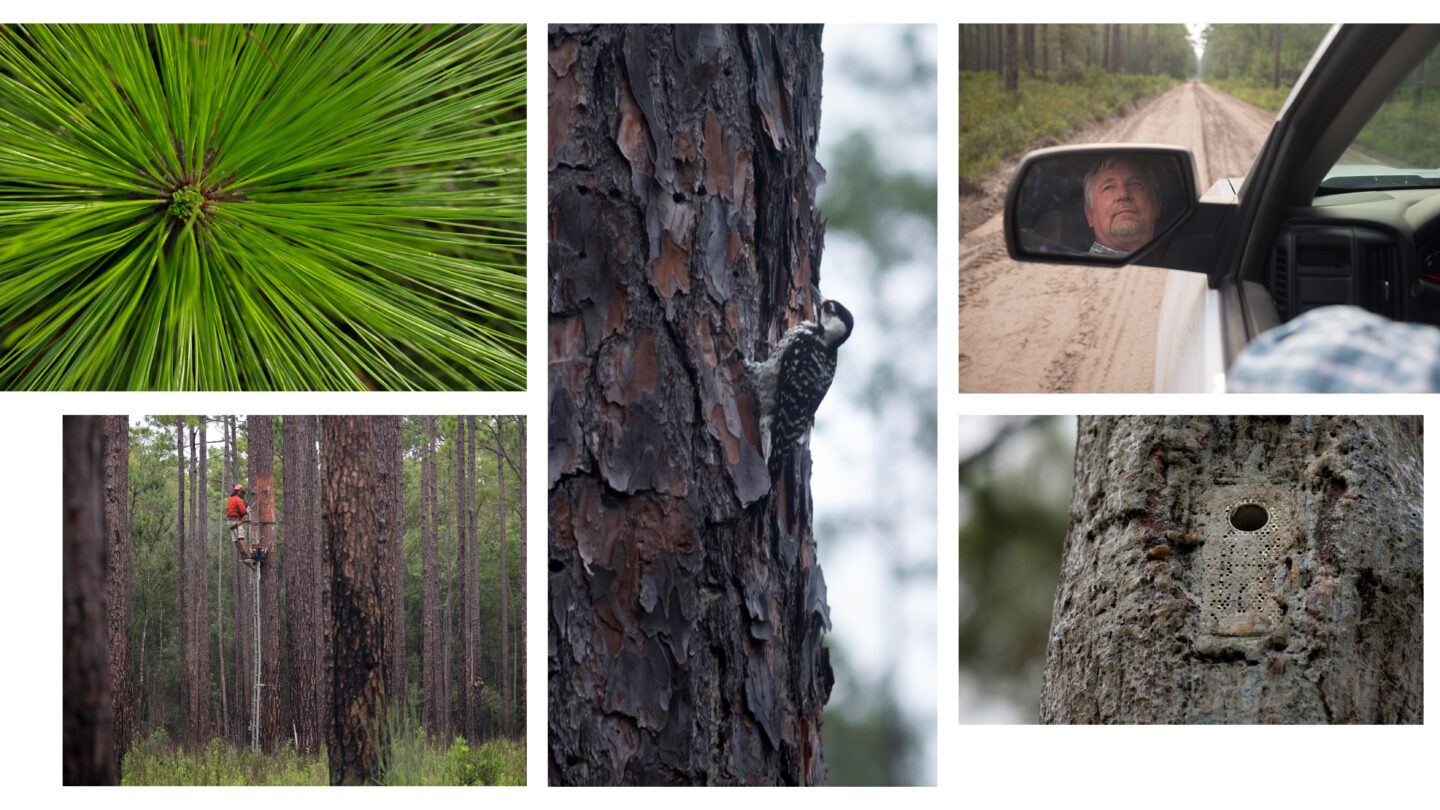
Now the U.S. Fish and Wildlife Service is considering changing the status of the red-cockaded woodpecker, from endangered, down to threatened. Or maybe even taking it off the list entirely.
The agency wouldn’t talk on the record for this story, but sent a statement that, in part says, “the fact that we are able to consider reclassifying the woodpecker is a major accomplishment for conservation.”
And while it is an accomplishment, some are concerned that changing the woodpecker’s status now is a bad idea.
Commitments To Conservation
“The red-cockaded woodpecker is still working on recovering, it’s still being managed,” says Ramona McGee, an attorney at the Southern Environmental Law Center. She says the woodpeckers can’t survive without those two important things: controlled burns and artificial cavities.
“It’s still reliant on those conservation measures that the Fish and Wildlife Service, state agencies, the military, all these stakeholders have been doing for years,” she says.
McGee says she’d even be concerned about changing the bird from endangered to threatened because the Trump administration has revised regulations related to the Endangered Species Act, including changes to threatened species that could mean they lose some protections.
The revisions wouldn’t work retroactively; if species are already protected, how they’re treated wouldn’t change. But if the red-cockaded woodpecker’s status changes, from endangered to threatened, the new regulations would come into effect. A group of states and environmental groups are challenging the changes to the Endangered Species Act regulations.
A spokesman for U.S. Fish and Wildlife says its decisions are based on the best available science and commercial information, and if the status changes, a threatened listing could still include conservation measures.
McGee also cites emails her group obtained through records requests, in which the Fish and Wildlife Service asks states if they’ll commit to continuing to protect the woodpecker for decades, even if the federal government changes its status. Some states, including Georgia, say they can’t commit because they don’t know if they can afford it.
“The states are strapped for money, and they don’t have the resources to do this sort of management that’s required for red-cockaded woodpeckers on their own,” McGee says.
A spokesman for Fish and Wildlife says many of the agency’s partners have said they will keep doing the things the birds need.
Georgia officials declined an interview but in an emailed statement, wildlife conservation section chief Jon Ambrose wrote of the state’s conservation work, “These efforts are funded primarily through federal sources. The Wildlife Resources Division is committed to managing and monitoring red-cockaded woodpeckers as resources allow. The agency also values its partnership with the U.S. Fish and Wildlife Service and looks forward to continuing collaborative efforts to achieve the recovery of red-cockaded woodpeckers.”
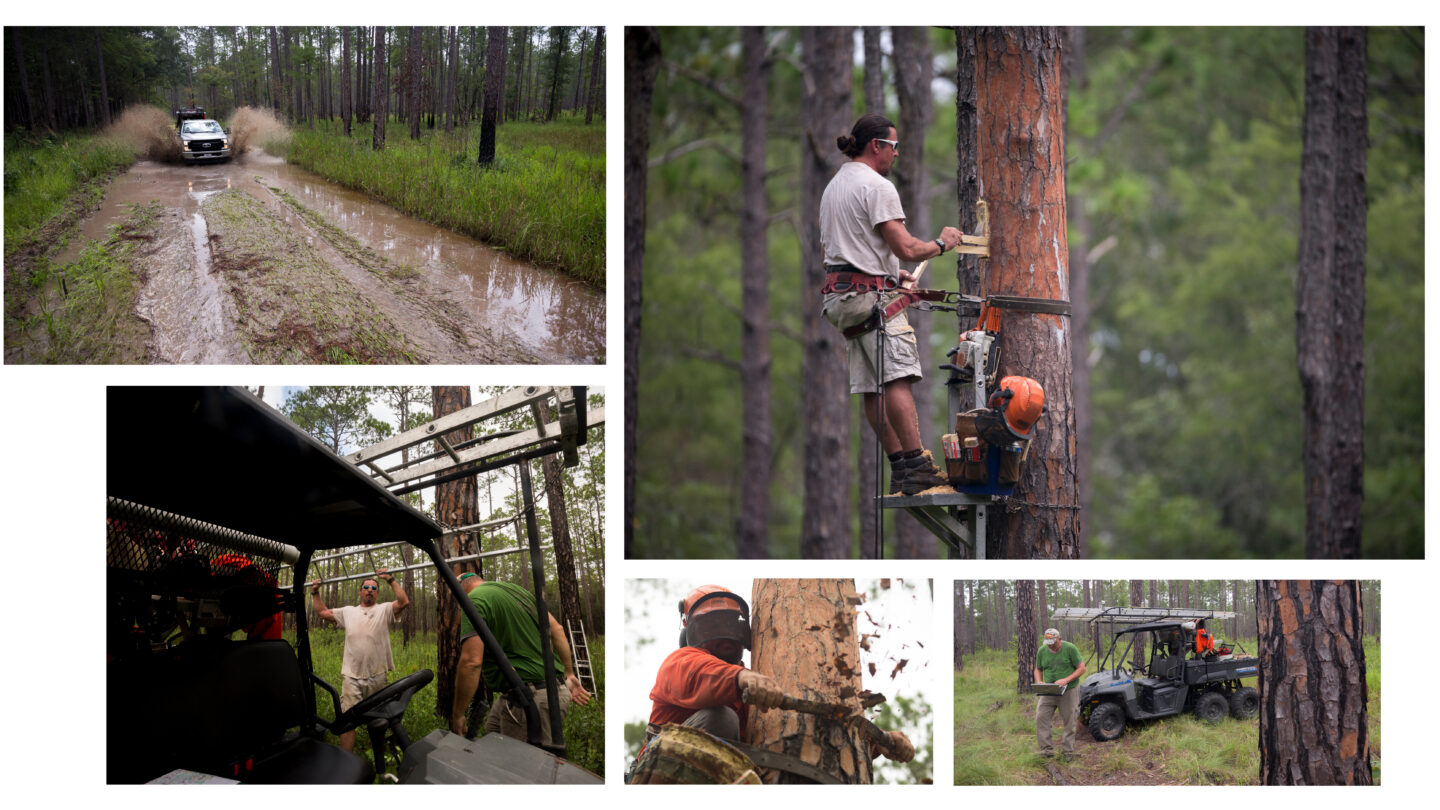
‘We Want It To Have A Good Ending’
Later in the morning at Fort Stewart, wildlife biology technician Ryan Adamson prepares to climb a tree to insert an artificial cavity. He tests a chainsaw before climbing a ladder 20-or-so feet up. He braces a platform against the tree and perches there.
He scrapes bark off the tree, then cuts a cube of wood out of the trunk, to be replaced by a bird box with a cavity drilled into it. Researchers say the red-cockaded woodpeckers often move right in; Adamson laughs that they’re building government housing for birds.
At Fort Stewart, Carlile says they will continue burning, no matter what happens with the woodpeckers’ conservation status. As far as inserting artificial cavities goes, Fort Stewart will continue with those as long as the Army installation’s natural resource management plan requires it.
Scientists, including Jeff Walters, say they could live with the woodpecker being downlisted to threatened – but only if humans keep helping.
“It’s kind of a tricky situation,” Walters says.
He says clearly the woodpeckers are doing better than they were; one could make the case that maybe they don’t need to be considered endangered anymore, “But the problem is, you have to continue the management,” he says. “If you stop burning, and you stop using artificial cavities, then their populations will immediately start to decline again, and we’ll be right back where we started from.”
Removing protections entirely, Walters says, scares him. Not only because that could mean less of what the woodpeckers need now, but also because human-caused climate change looks like it could be a problem. Hurricanes can severely affect populations. And the bird’s population will always be fragmented and small compared to what it was before the loss of most of the longleaf pine forests.
Still, Walters says, he’s proud of the recovery of the red-cockaded woodpecker. He’s not the only person whose career has been dedicated to the little bird
“A lot of people regard this as one of the big success stories with conservation in the United States,” he says. “It would be a shame for this success story to have a bad ending. We want it to have a good ending.”

